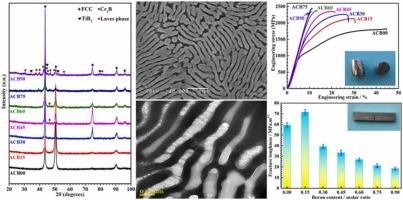Abstract
High entropy alloys (HEAs) have attracted considerable attention due to their excellent mechanical properties, which provides new insights for designing next generation structural materials. A series of Al0.2Co1.5CrFeNi1.5Ti0.5Bx (x = 0, 0.15, 0.3, 0.45, 0.6, 0.75 and 0.9, in molar ratio) HEAs was prepared by vacuum arc melting to investigate the effect of boron doping on the phase evolution, microstructure transformation and mechanical properties. The results indicated that the HEAs with trace boron doping (x = 0.15) maintained single FCC phase, while it evolved to FCC phase, in-situ borides (TiB2 and Cr2B) and Laves phase when the boron molar ratio higher than 0.3. With the boron molar content increased from 0 to 0.9, the microstructures of the HEAs transformed from complete dendrite to dendrites, irregularly shaped TiB2, needle-shaped Cr2B and lamellar eutectic structure which composed by alternate layers of FCC phase and Laves phase. B doping improved the strength and hardness of the HEAs. The enhanced mechanical properties of the boron doped HEAs was attributed to the synergistic strengthening effect among interstitial solid solution strengthening, second phase strengthening, dislocation strengthening, fine grain strengthening and heterostructure strengthening. (C) 2021 Elsevier B.V. All rights reserved.

Keywords Plus:METALLIC GLASSESSTRENGTHENHANCEMENTBEHAVIOR
Published in JOURNAL OF ALLOYS AND COMPOUNDS,Volume896;10.1016/j.jallcom.2021.162852,MAR 10 2022


